Nicole schreibt...
Brittany 2015 |
 |
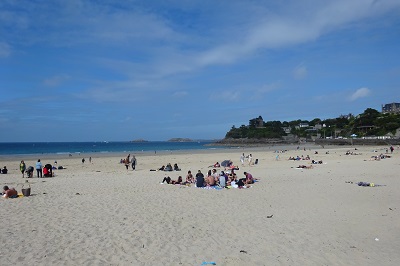 Exploring a new area of France has become one of my favorite pastimes holiday-wise, so a logical follow-up to the trips to Normandy, the Loire Valley and also the Channel Islands (British, but so close) was Brittany, the western-most peninsula of northern France. Brittany is best-known as the home of fabulously stubborn and independent-minded Bretons from Asterix who gave Julius Caesar frequent headaches to today's farmers dumping lorry-loads of cowshit at the gates of the Élysée Palace in Paris to voice their discontent with politicians. It's also full of gorgeous coastal areas, beaches, medieval towns and far too much to see in one week.
Exploring a new area of France has become one of my favorite pastimes holiday-wise, so a logical follow-up to the trips to Normandy, the Loire Valley and also the Channel Islands (British, but so close) was Brittany, the western-most peninsula of northern France. Brittany is best-known as the home of fabulously stubborn and independent-minded Bretons from Asterix who gave Julius Caesar frequent headaches to today's farmers dumping lorry-loads of cowshit at the gates of the Élysée Palace in Paris to voice their discontent with politicians. It's also full of gorgeous coastal areas, beaches, medieval towns and far too much to see in one week.First destination was the famous seaside resort of Dinard on the north coast, just across the estuary of the Rance from equally famous St. Malo, which we reached in the late afternoon after an eight-hour drive. The weather was fine and there were still plenty of people soaking up the sun on the "Grand Plage" in the middle of town. We went for a stroll and had our first encounter with Breton cuisine by way of a "Galette complete" with cidre. Galettes being the hearty cousin of the sweet and better known crêpes, which come with a variety of fillings. "Complete" are they, when done with ham, cheese and a fried egg.
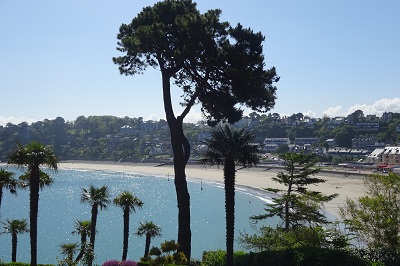
Next morning we headed to crazily beautiful Perros-Guerrec, another seaside resort about an hour's drive west of Dinard, that really looked like it should be on the Côte d'Azur further south. It's the starting point for the 5 kilometre long "Sentier des Douaniers", the path of the guards who once patrolled here to catch smugglers bringing contraband in from merry old England. These days it's a well-known hiking path along one of the most beautiful bits of the Côte de Granit Rose with its pinkish rock formations, the result of volcanic activity many millenia ago.
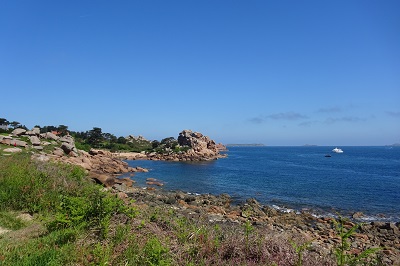
|
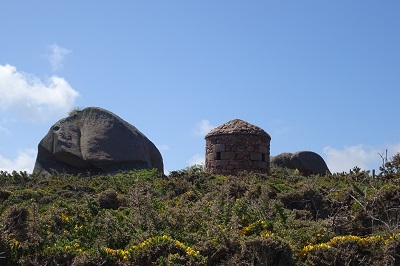 |

|
 |
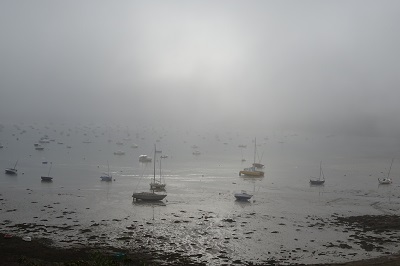
The following day dawned with a thick mist over the Rance estuary, creating a rather splendidly eerie light on the sea. Luckily the mists lifted later as we finally went across the estuary to visit St. Malo, that fabulous nest of corsairs, who raided English and Dutch vessels in the Channel for centuries. The whole old town is still surrounded by a thick town wall and thusly called "Intra-Muros". - with not a single ugly modern building in sight. The name St. Malo, by the way, stems from the Welsh monk Maclow, who was one of the many Celts who moved across the Channel in 6th century and became one of the "seven saints" that christianized the area.
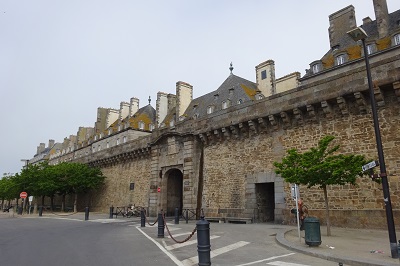
|
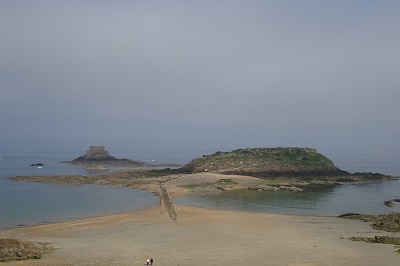 |
This was a tour along the coast to Cap Fréhel and the rather splendid Fort La Latte, perched on an outcrop nearby to protect Brittany from the terrible English across the Channel. It was originally built in 14th century, then strengthened during the reign of the sun king, Louis XIV.
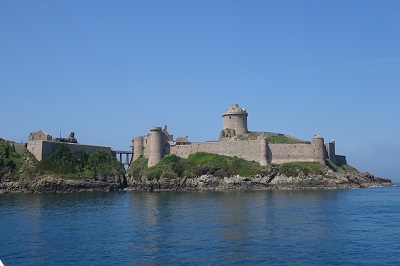
|
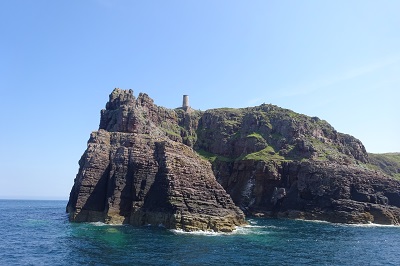 |
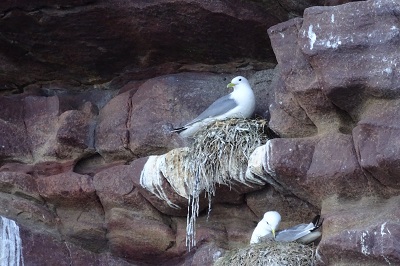
|
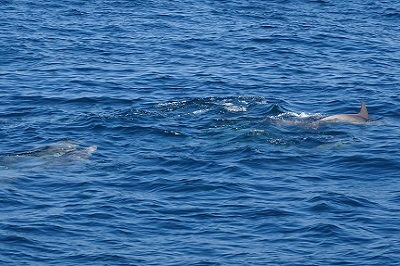 |
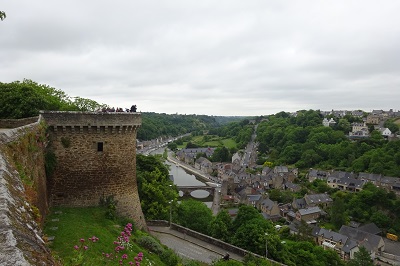 The next morning it was time to say goodbye to lovely Dinard and move on south with a few stops along the way. The first being Dinan, another town famous for its beautiful medieval core and one of the major tourist attractions of Brittany. The town is about a thousand years old and some streets look like they have hardly changed since, lined as they are with ancient half-timbered buildings, some of them so crooked you really don't know how they manage to remain standing (or people actually living in them!) If it wasn't for the sodding cars, these pictures may be the closest you get of a colour image of 15th century France.
The next morning it was time to say goodbye to lovely Dinard and move on south with a few stops along the way. The first being Dinan, another town famous for its beautiful medieval core and one of the major tourist attractions of Brittany. The town is about a thousand years old and some streets look like they have hardly changed since, lined as they are with ancient half-timbered buildings, some of them so crooked you really don't know how they manage to remain standing (or people actually living in them!) If it wasn't for the sodding cars, these pictures may be the closest you get of a colour image of 15th century France. We walked around the old town for a while, then moved on to something that had been very close to my own geeky heart - the Forêt de Brocéliande, or more prosaically, the Forêt de Paimpont, in the middle of Brittany.
 |
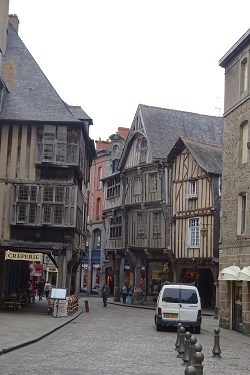 |
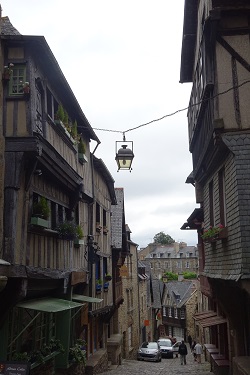 |
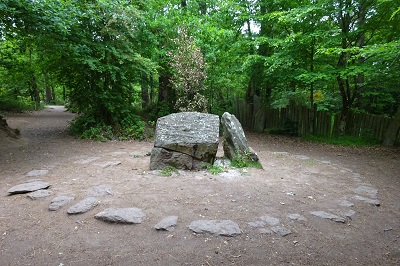 Whether it's ancient myths or just a savvy marketing manager, who knows, but the forest is closely associated with the legends of King Arthur. Today a 70 kilometre tourist circuit has been mapped out leading to some places of Arthurian myth. More by fool's luck than anything (the main road to Paimpont was closed off, sending us on a bizarre detour) we came upon "Merlin's Tomb" from where a four kilometre hiking path led to the spring of eternal youth (yes, that puddle down left) and the lake of Viviane, where she kept Arthur's sword Excalibur and where it returned. Even if it's all hogwash, it was still a lovely hike through completely unspoilt nature with no touristy nonsense at all.
Whether it's ancient myths or just a savvy marketing manager, who knows, but the forest is closely associated with the legends of King Arthur. Today a 70 kilometre tourist circuit has been mapped out leading to some places of Arthurian myth. More by fool's luck than anything (the main road to Paimpont was closed off, sending us on a bizarre detour) we came upon "Merlin's Tomb" from where a four kilometre hiking path led to the spring of eternal youth (yes, that puddle down left) and the lake of Viviane, where she kept Arthur's sword Excalibur and where it returned. Even if it's all hogwash, it was still a lovely hike through completely unspoilt nature with no touristy nonsense at all.
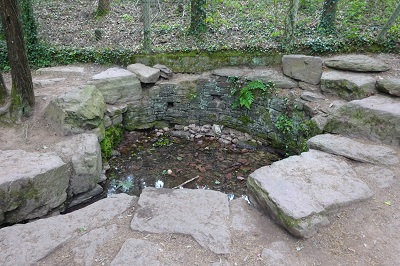
|
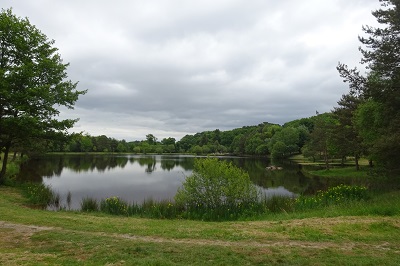 |
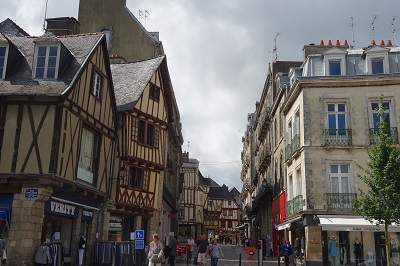 Lastly we arrived at our second home, the charming Maison de la Garenne in Vannes, a pretty little chateau just outside the gates of the old town. Located on the Golfe du Morbihan on the south coast, Vannes used to be the capital of Brittany for a while centuries ago and it was here their last independent queen Anne de Bretagne signed them over to France - much against her own will and stubbornly insisting on concessions, some of which still exist today, for example that the French government cannot impose tolls on Brittany's highways (a joy even for foreign drivers tired of the highway robbery called péage). Vannes has a beautiful historical old town with more half-timbered buildings and an impressive cathedral, as well as a lovely port. Here's a photo to show how nicely ancient moats can be converted into gardens and of the ancient "washing houses" that lined the canal.
Lastly we arrived at our second home, the charming Maison de la Garenne in Vannes, a pretty little chateau just outside the gates of the old town. Located on the Golfe du Morbihan on the south coast, Vannes used to be the capital of Brittany for a while centuries ago and it was here their last independent queen Anne de Bretagne signed them over to France - much against her own will and stubbornly insisting on concessions, some of which still exist today, for example that the French government cannot impose tolls on Brittany's highways (a joy even for foreign drivers tired of the highway robbery called péage). Vannes has a beautiful historical old town with more half-timbered buildings and an impressive cathedral, as well as a lovely port. Here's a photo to show how nicely ancient moats can be converted into gardens and of the ancient "washing houses" that lined the canal.

|
|
From here we continued to Quimper, the capital of the departement Finistère, which is known for its faïences (which were freakishly expensive) and its immense cathedral, dedicated to local Saint Corentin (one of those seven Welsh monks). The Bretons did as long over it as the Colognians, starting their cathedral in 1239 and not finishing it till 1850, which I found rather endearing. Quimper was also a good spot for a nice lunch of Galettes Completes before moving on to... Quimperlé.
Next stop was the Fortress of Saint-Louis which once protected the Port de l'Orient set up by the French East India Company in 17th century on behest of Louis XIV - which later became the city of Lorient and the fortress now holds the Musée de la Compagnie des Indes, which I wanted to see. It showed the development of the French colonies and the role of the company in the slave trade from Western Africa as well as nice exhibits from the Far East. Though admittedly, what I liked best where the lovely dioramas of old sailing ships "sliced open" to show what life was like inside them.
|
|
|
There was another small museum inside the fortress, this one dedicated to the lifesavers and their boats of Brittany and to underwater archaeology.
Last stop on this busy day was Carnac, famous for its fields of megalithic menhirs - endless rows of stones that were set up around 5000 BC and nobody has a clue why. The nice thing was that the French just let you pull into a parking lot and wander along the perimeter for a bit to snap pictures without charging you for it (although you could add the museum if you were so inclined - I wasn't). As it was, it was rather amazing to look at, but I didn't see a point in lingering long or seek out more than one of the "alignements" of stones.
After this truly busy day the last day would end on a calm relaxing note - with a boat tour in the insanely picturesque Golfe du Morbihan. I had never really understood the attraction of having a "weekend home" or a boat, but on this lovely sunny day with the whole bay filled with yachts and boats of all shapes and sizes, I suddenly realized just how wonderful it can be.
Here are a few pictures of the bay, pretty Port Navalo at the "exit" of the bay where it meets the open Bay of Biscay and of a prehistoric tomb (there were also a handful of menhirs nearby). And finally of the wonderful little beach on the Île des Moines, where we spent a few hours doing nothing at all:
|
|
|
|
|
|
A lovely quiet end to a busy trip in what was certainly one of the most beautiful and picturesque areas I've ever visited. Mind you, it helped that we were lucky with the weather and enjoyed some days of wonderful sunshine. But the many interesting places, the medieval old towns and the beautiful beaches all made it a perfect destinations - as did the charming Bretons who made us truly feel welcome everywhere.
Copyright © All Rights Reserved